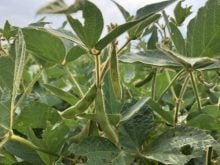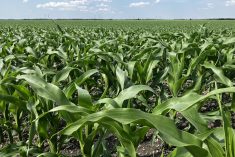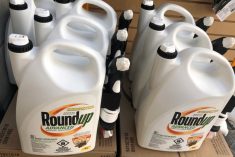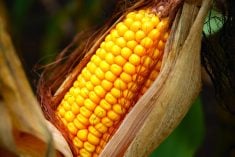A Bayer CropScience fungicide is being pressed into service against sudden death syndrome (SDS) in Canadian soybeans.
Bayer on Monday launched a new soybean seed treatment dubbed ILeVO, a suspension containing its Group 7 fungicide fluopyram at a rate of 600 grams per litre. ILeVO will be the first soybean seed treatment registered for use against SDS in Canada, the company said.
Registered in Canada for control of early-season infection by Fusarium virguliforme, the fungal pathogen that causes SDS, ILeVO is approved for use in commercial seed treatment plants and mobile treater systems, for closed transfer and closed treatment equipment only.
Read Also

India slaps 30 per cent import duty on yellow peas
India has imposed a 30 per cent duty on yellow pea imports with a bill of lading date on or after Nov. 1, 2025.
Bayer has had fluopyram in its roster since 2014, when the chemical picked up conditional registration as an active ingredient in fungicides Propulse, Luna Tranquility and Luna Privilege. Health Canada’s Pest Management Regulatory Agency (PMRA) granted fluopyram full registration in May this year.
First seen in soybeans in Arkansas in 1971, the SDS pathogen has since been confirmed in most soybean-growing areas of the U.S., and in Ontario, according to the American Phytopathological Society.
F. virguliforme overwinters on crop residue and is now occurring “more frequently” in fields across Ontario, Bayer said Monday. The disease results in average annual yield loss of about 20 per cent, but can cause losses of up to 60 per cent in a growing season, Bayer added.
The company noted the disease has proven difficult to identify and is often misdiagnosed. It’s typically not detectable on the foliage of plants until after the beginning of flowering, according to the APS.
The disease often, but not always, occurs in a disease complex with soybean cyst nematode (SCN), the APS said. When it occurs in the presence of SCN, disease symptoms occur earlier and are more severe.
“With the increased cases of SDS in Ontario putting pressure on growers, it’s important to have tools ready to help protect their fields,” Albert Tenuta, field crop pathologist for Ontario’s agriculture ministry (OMAFRA), was quoted as saying in Bayer’s release Monday.
“Growers are continuing to plant in earlier, wetter conditions and reducing the risk of infection at planting will help maximize yields.”
According to OMAFRA, the pathogen prefers cool, moist soil conditions. Well-fertilized or “vigorously growing” fields are most likely to show SDS symptoms.
Crop rotation with corn and cereals can also cut the incidence of SDS, OMAFRA added, noting the disease occurs most often on reduced-tillage fields. Incorporating or removing infested residue may also cut the risk of SDS.
ILeVO’s efficacy has been shown in field trials in both the U.S. and Canada over the past five years, including third-party trials with OMAFRA and the University of Guelph, Bayer said.
ILeVO, the company said, also includes a feature that signals a successful application: a “halo effect,” often visible on the edges of the cotyledons of a treated plant. — AGCanada.com Network












